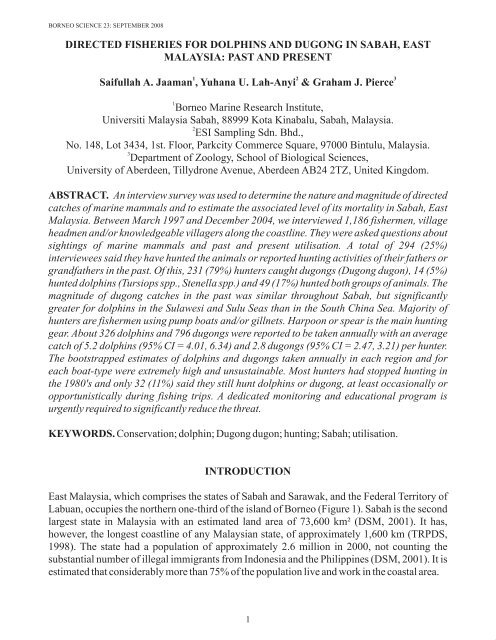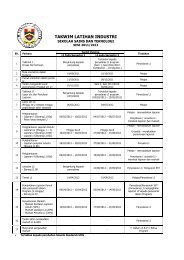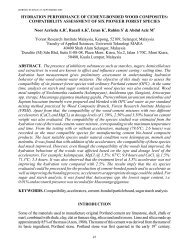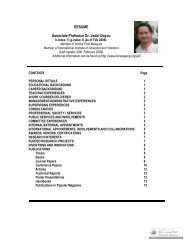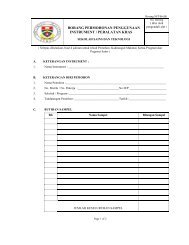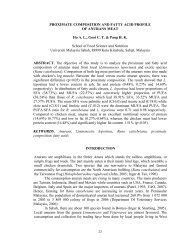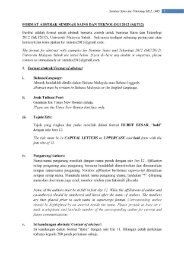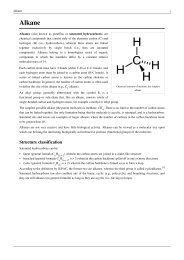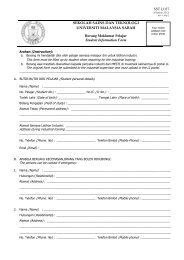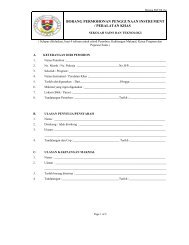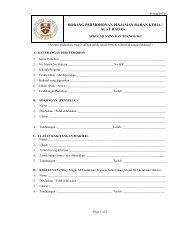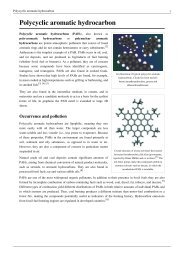Volume 23 - SST - Sekolah Sains & Teknologi - Universiti Malaysia ...
Volume 23 - SST - Sekolah Sains & Teknologi - Universiti Malaysia ...
Volume 23 - SST - Sekolah Sains & Teknologi - Universiti Malaysia ...
- No tags were found...
You also want an ePaper? Increase the reach of your titles
YUMPU automatically turns print PDFs into web optimized ePapers that Google loves.
BORNEO SCIENCE <strong>23</strong>: SEPTEMBER 2008DIRECTED FISHERIES FOR DOLPHINS AND DUGONG IN SABAH, EASTMALAYSIA: PAST AND PRESENT1 2 3Saifullah A. Jaaman , Yuhana U. Lah-Anyi & Graham J. Pierce1Borneo Marine Research Institute,<strong>Universiti</strong> <strong>Malaysia</strong> Sabah, 88999 Kota Kinabalu, Sabah, <strong>Malaysia</strong>.2ESI Sampling Sdn. Bhd.,No. 148, Lot 3434, 1st. Floor, Parkcity Commerce Square, 97000 Bintulu, <strong>Malaysia</strong>.3Department of Zoology, School of Biological Sciences,University of Aberdeen, Tillydrone Avenue, Aberdeen AB24 2TZ, United Kingdom.ABSTRACT. An interview survey was used to determine the nature and magnitude of directedcatches of marine mammals and to estimate the associated level of its mortality in Sabah, East<strong>Malaysia</strong>. Between March 1997 and December 2004, we interviewed 1,186 fishermen, villageheadmen and/or knowledgeable villagers along the coastline. They were asked questions aboutsightings of marine mammals and past and present utilisation. A total of 294 (25%)interviewees said they have hunted the animals or reported hunting activities of their fathers orgrandfathers in the past. Of this, <strong>23</strong>1 (79%) hunters caught dugongs (Dugong dugon), 14 (5%)hunted dolphins (Tursiops spp., Stenella spp.) and 49 (17%) hunted both groups of animals. Themagnitude of dugong catches in the past was similar throughout Sabah, but significantlygreater for dolphins in the Sulawesi and Sulu Seas than in the South China Sea. Majority ofhunters are fishermen using pump boats and/or gillnets. Harpoon or spear is the main huntinggear. About 326 dolphins and 796 dugongs were reported to be taken annually with an averagecatch of 5.2 dolphins (95% CI = 4.01, 6.34) and 2.8 dugongs (95% CI = 2.47, 3.21) per hunter.The bootstrapped estimates of dolphins and dugongs taken annually in each region and foreach boat-type were extremely high and unsustainable. Most hunters had stopped hunting inthe 1980's and only 32 (11%) said they still hunt dolphins or dugong, at least occasionally oropportunistically during fishing trips. A dedicated monitoring and educational program isurgently required to significantly reduce the threat.KEYWORDS. Conservation; dolphin; Dugong dugon; hunting; Sabah; utilisation.INTRODUCTIONEast <strong>Malaysia</strong>, which comprises the states of Sabah and Sarawak, and the Federal Territory ofLabuan, occupies the northern one-third of the island of Borneo (Figure 1). Sabah is the secondlargest state in <strong>Malaysia</strong> with an estimated land area of 73,600 km² (DSM, 2001). It has,however, the longest coastline of any <strong>Malaysia</strong>n state, of approximately 1,600 km (TRPDS,1998). The state had a population of approximately 2.6 million in 2000, not counting thesubstantial number of illegal immigrants from Indonesia and the Philippines (DSM, 2001). It isestimated that considerably more than 75% of the population live and work in the coastal area.1


